To set your baitcaster’s drag for smooth fishing, start by adjusting the star-shaped knob near the handle to about 20–30% of your line’s breaking strength. Pull line through the guides and tighten gradually until you feel consistent slippage—the rod should flex in its upper third. Test with a scale if possible, and fine-tune based on your target species: lighter for panfish, firmer for bass and pike. Proper calibration prevents break-offs while maintaining control, and understanding how to adjust during the fight makes all the difference.
TLDR
- Set drag to 20–30% of line breaking strength as a baseline; adjust lower for panfish or higher for pike and saltwater species.
- Pull line through rod guides and tighten star knob until smooth, consistent slippage occurs at the desired load.
- Use a fishing scale at the rod tip to measure drag force precisely when testing slippage.
- Tighten drag near heavy cover by about 3% to prevent fish from reaching structure and causing break-offs.
- Combine star drag with thumb bar pressure for layered control during sudden fish surges or hard runs.
What Is a Baitcaster Drag System and How Does It Work?
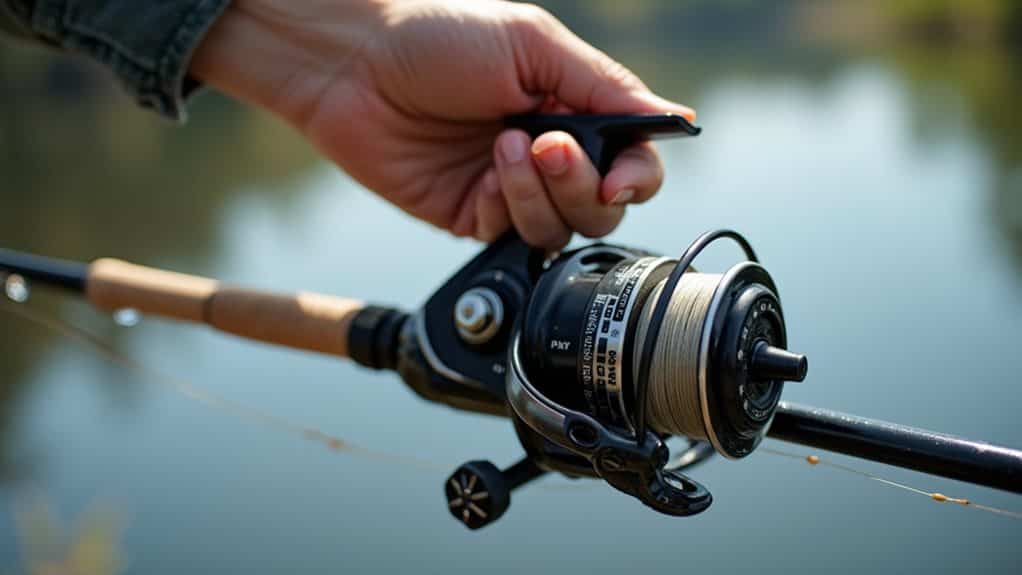
When you’re reeling in a hard-fighting fish, the drag system on your baitcaster serves as a critical safety mechanism that controls how much resistance the spool applies when line is pulled out.
Located near the handle as a star-shaped knob, it works by applying friction through internal washers or discs. Turning the knob adjusts pressure on these components, regulating how freely your spool rotates under tension. Tightening the drag makes it harder for fish to strip line from your reel, while loosening it allows the fish more play during the fight. Many anglers pair baitcasters with high-quality fish finders to target productive spots and reduce wasted time on the water.
Why Proper Drag Settings Matter for Fishing Success
Although the drag system might seem like just another adjustment on your baitcaster, it’s actually one of the most critical factors determining whether you’ll successfully land a fish or watch it swim away with your lure.
Proper drag prevents line breakage during hard runs, maintains consistent pressure throughout the fight, and allows fish to tire naturally without pulling the hook free or snapping your line against structure. Many quality combos pair well-matched reels and rods to help maintain consistent drag performance during long fights with larger fish, especially when using graphite rods for sensitivity and lightness.
When fishing near rocks, branches, barnacles, or pilings, you should increase your drag setting by approximately 3% to prevent fish from pulling into structure where they can break off.
Matching Drag Tension to Line Strength and Pound Test
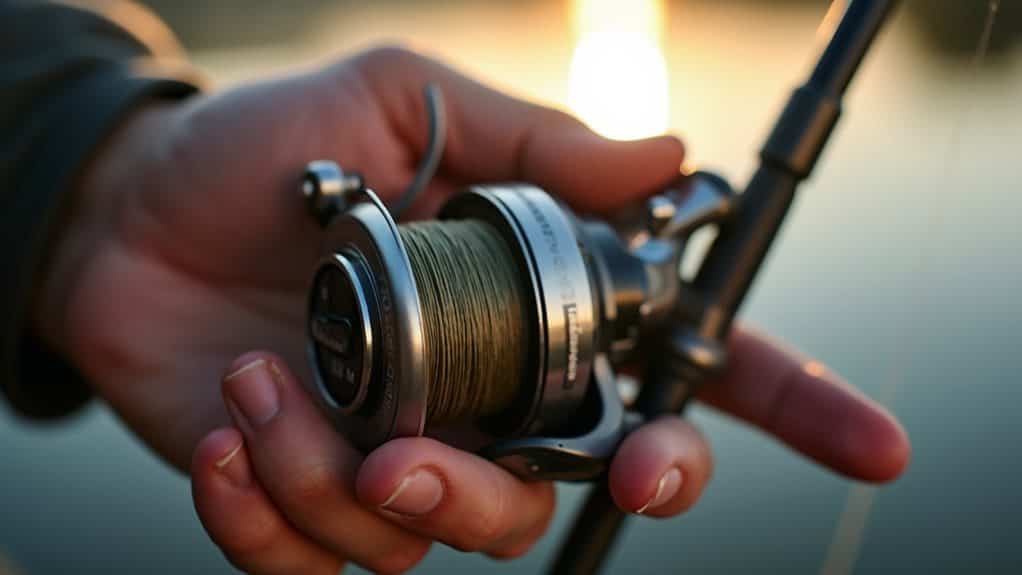
The relationship between drag tension and line strength forms the foundation of proper baitcaster setup, with most anglers following the guideline of setting drag to 20-30% of their line’s breaking strength depending on the specific pound test they’re using.
Monofilament’s natural stretch allows you to set drag at the higher end of this range, while braided lines require approximately 5% less due to their minimal stretch properties, preventing sudden break-offs during fish surges.
Many anglers also find it helpful to track their fishing routes and spots using a built-in GPS on their devices to return to productive areas.
Adjusting Drag Based on Target Fish Species and Size
Understanding your line’s capabilities matters little if you don’t account for the fish you’re actually targeting.
Set your drag at 10–15% of line strength for panfish and trout, 20–25% for bass and walleye, and 25–30% for pike, muskie, or saltwater species.
Adjust higher near structure to prevent fish from reaching cover, and lower in open water to allow controlled line slip during powerful runs.
Topwater fishing is often best at dawn and dusk, when fish are actively feeding and surface strikes increase.
Step-by-Step Method to Test Your Drag Settings
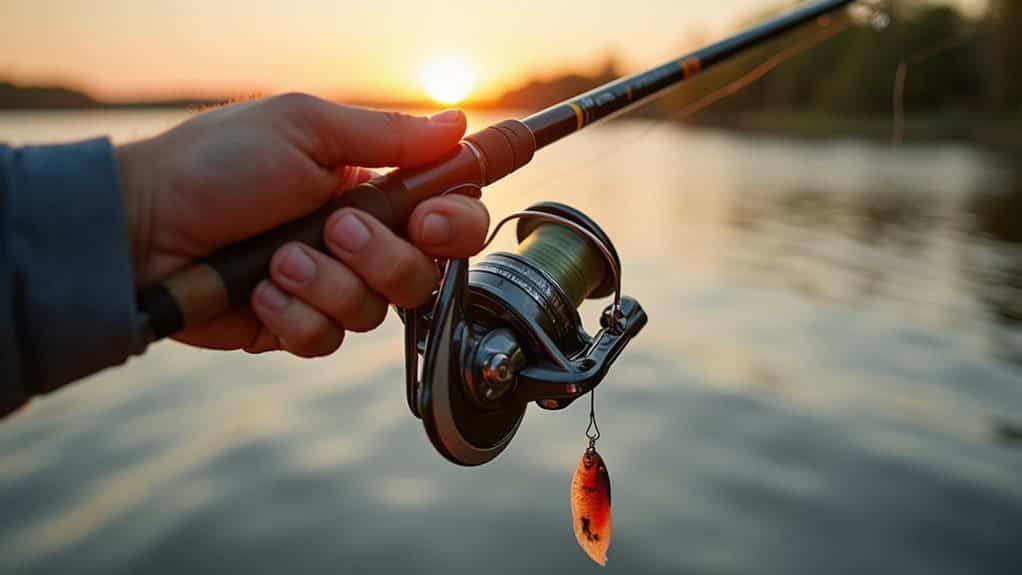
To test your drag settings effectively, you’ll want to thread your line through all the rod guides and pull steadily until you feel the drag begin to slip.
As you pull, watch where your rod bends—it should flex smoothly in the upper third rather than doubling over near the butt section, which indicates the drag is too tight.
Continue adjusting the drag knob and repeating this process until you achieve consistent slippage at your target pressure, typically around 20–30% of your line’s rated strength.
Pull Line Through Guides
Setting up your drag properly means putting it through a real-world test, and pulling line through the guides with a fishing scale gives you the most accurate measurement of what your drag will actually do when a fish makes a run.
Attach your scale to the line at the rod tip, then pull steadily until the drag slips, noting the reading to compare against your line’s breaking strength.
Observe Rod Bend Point
Properly testing your drag settings requires observing how your rod performs under load, and the bend point serves as a critical reference for understanding the relationship between your rod’s action and the amount of pressure your drag releases.
Pull line steadily while watching where your rod bends—ideally, you’ll see a smooth curve forming from tip toward the handle, indicating balanced drag pressure that won’t overstress your equipment or lose fish.
Adjust Until Slippage Occurs
Dialing in your drag requires a systematic approach where you intentionally pull line until the spool releases, revealing whether you’ve struck the right balance between holding power and fish-protecting give.
Gradually tighten the star knob, then pull line steadily with your fingers or attach a weight to simulate fish pressure.
When the spool just begins slipping smoothly without jerking, you’ve found your sweet spot—back off slightly for consistent performance.
Using Rod Bend as a Guide for Optimal Drag Calibration

When you’re calibrating your baitcaster’s drag system, using your rod’s natural bend as a reference point offers one of the most practical and intuitive methods available.
Pull line until your rod flexes substantially, and adjust the drag so it begins slipping at this load point.
This creates a three-tier safety system combining rod flex, line stretch, and drag slip to prevent breakage while maintaining hookset power.
Environmental Factors That Influence Drag Configuration
While mastering rod bend gives you a solid baseline for drag calibration, your perfectly dialed-in settings won’t stay perfect for long once you factor in what’s happening around you.
Water temperature affects line stiffness and drag washer expansion, while strong currents increase line pressure, demanding tighter settings. Saltwater accelerates corrosion, requiring looser drag to compensate for increased friction, and deep-water pressure compresses washers, altering tension consistency throughout your retrieve.
Combining Drag Control With Thumb Bar Technique
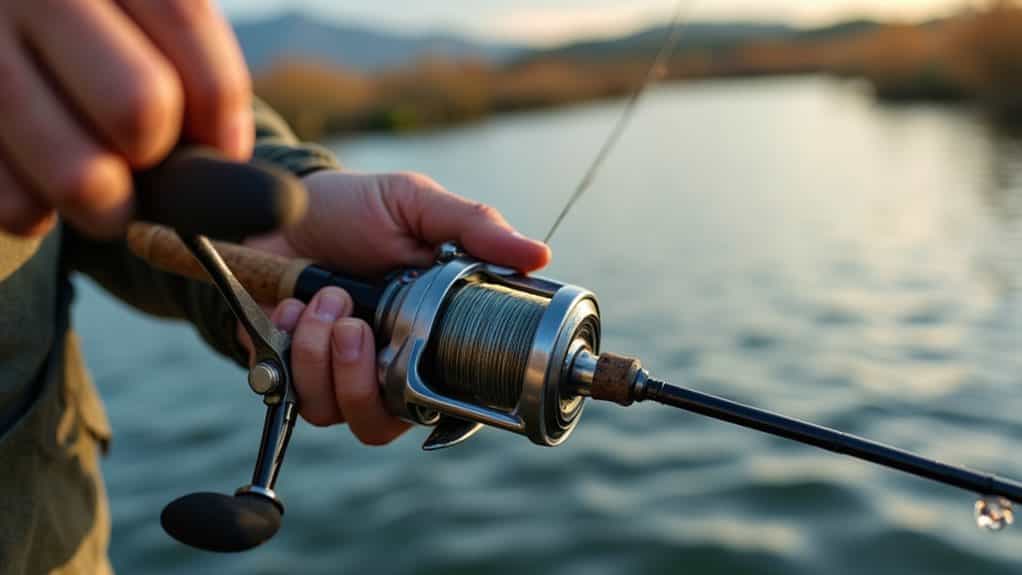
Your baitcaster’s star drag and thumb bar aren’t separate systems—they’re designed to work in tandem, giving you layered control that neither can provide alone.
Set your drag to 25% of line strength as a baseline, then use thumb pressure for instant adjustments during fish surges. This combination is especially critical in heavy cover, where locked-down drag requires manual spool control to prevent line breaks.
Common Drag Setting Errors and How to Avoid Them
Commanding the coordination between your drag and thumb control sets you up for success, but even experienced anglers make preventable mistakes that cost them fish.
Setting drag too tight causes premature line breakage during powerful runs, while too-loose settings allow excessive line stripping and tangles.
Match your drag to line type and lure choice—tighter for jigs with heavier line, looser for crankbaits with trebles—and test adjustments on-water regularly.
Maintenance Tips for Consistent Drag Performance
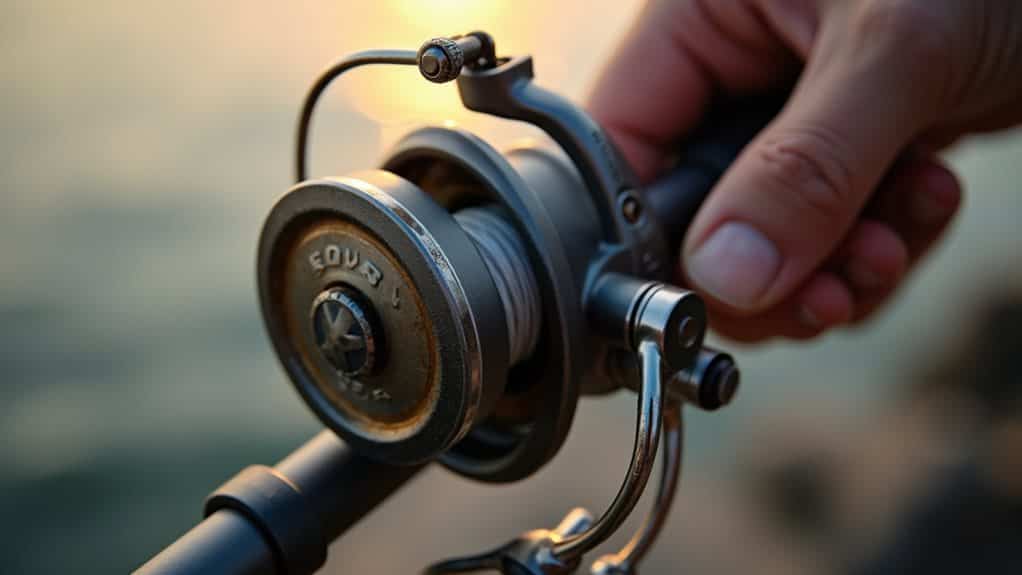
Maintaining consistent drag performance on your baitcaster requires attention to three critical areas that directly impact how smoothly your drag engages and releases line under pressure.
You’ll need to establish a routine that includes regular cleaning and lubrication of drag components, frequent inspection of drag washers for wear or damage, and proper storage practices between fishing trips.
Regular Cleaning and Lubrication
Consistent drag performance relies heavily on a regular cleaning and lubrication schedule that prevents dirt buildup and keeps internal components functioning smoothly.
After every saltwater use, mist your reel with clean water and air dry it away from direct sunlight.
For freshwater fishing, perform monthly maintenance using mild dish soap, a soft toothbrush, and appropriate reel oil on bearings while applying specialized drag grease sparingly to protect washers and gears.
Inspect Drag Washers Frequently
Regular inspections of your drag washers represent one of the most overlooked yet critical aspects of baitcaster maintenance, and you’ll want to examine them every few fishing trips or at least once per season to catch problems before they affect your performance on the water.
Watch for inconsistencies like jerky operation or slipping, discoloration, warping, or visible damage. Test smoothness by gradually tightening the drag knob—any hesitation signals trouble.
Proper Storage Between Trips
Storing your baitcaster correctly between fishing trips can dramatically extend the life of your drag system and guarantee it performs flawlessly when you need it most.
Always loosen the drag star completely to relieve spring washer pressure and prevent deformation.
Keep your reel in a dry, cool location away from direct sunlight, preferably in a protective case with silica gel packs to control moisture and minimize corrosion.
Fine-Tuning Drag During Active Fishing Situations
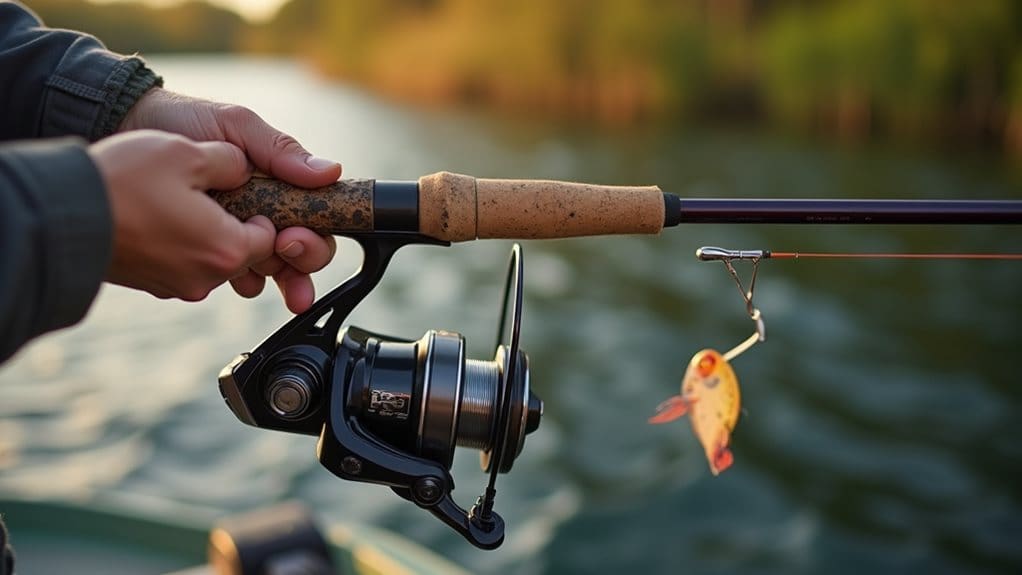
Once you’ve hooked into a fish, the real test of your drag system begins, and being able to make quick adjustments can mean the difference between landing your catch and watching it break off. Loosen drag slightly during hard runs to prevent line breakage, then tighten it when fish becomes stubborn.
Around heavy cover, increase drag pressure by about 3% to steer fish away from snags while maintaining enough slip for safety.
Final Note
You’ve now got the knowledge to dial in your baitcaster’s drag system for any fishing situation. Remember, proper drag settings protect your line, prevent break-offs, and give you the control needed to land more fish. Start with the 25-30% rule for your line’s pound test, then adjust based on species and conditions. Practice testing your drag regularly, maintain your reel’s components, and don’t hesitate to make on-the-water adjustments when fish behavior demands it.




